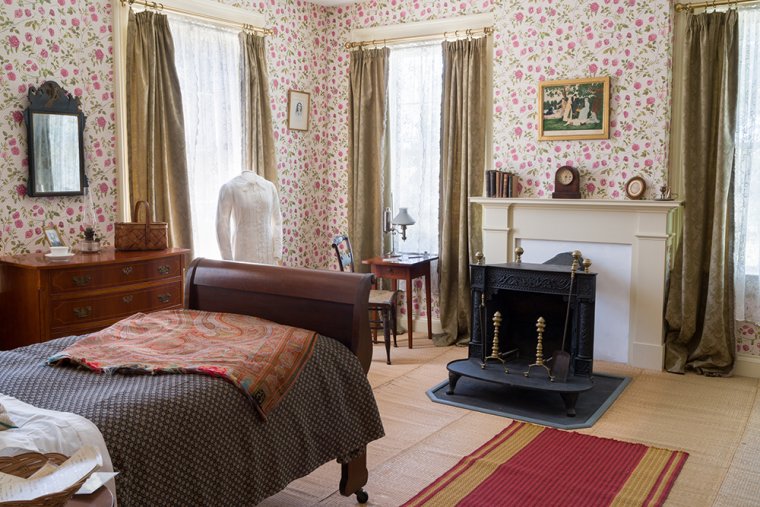At the Emily Dickinson Museum in Amherst, Massachusetts, visitors step directly into the private haven where the poet wrote with such incendiary vision. Here, in the Dickinson family’s pair of historic homes, says Brooke Steinhauser, senior director of programs, fans can linger over the poet’s “diminutive desk,” positioned by a window to receive the best light and a view of the family’s hay meadow—but they’ll also be reminded of the ailing mother in the bedroom just down the hall, needing her care. They’ll see a replica of the piano that let her fill the house with music, and the “riotous” wallpaper Dickinson chose for her space, complicating and deepening their sense of who Dickinson was. Still, perhaps few guests leave the house as changed, as moved, as Dickinson’s fellow writers—even those who are luminaries themselves. One lauded poet, Steinhauser recalls, was shown the home and invited to write in it—but felt too awed to consider the offer. Another high-profile writer was so stirred by the sight of the poet’s room that she crawled, uninvited, under Dickinson’s bed.

Emily Dickinson’s bedroom at the Emily Dickinson Museum in Amherst, Massachusetts.
(Credit: Courtesy of Emily Dickinson Museum, photo by Kaelan Burkett)Wherever you are on your personal journey as a writer, a stop at the home of a literary hero can be a revelation, inspiring and invigorating your writing in ways you might not expect. Such a visit can connect you with the energy of the writers who first inspired you, and remind you of the day-to-day reality from which all of us make our art. While some writers’ homes offer residency programs that allow a new generation to live and work in these charged spaces, it’s entirely possible to tap into some of the same magic with a more straightforward visit. Such a pilgrimage can be planned on your own schedule and budget. And because writers’ historic homes are maintained across the country, such inspiration may only be a road trip away.
Today’s writers—both emerging and established—are often particularly welcome visitors at historic literary homes. At the Flannery O’Connor Childhood Home Foundation & Museum in Savannah, Georgia, staff are charmed when visitors channel O’Connor’s creative energy as they explore the stately townhouse on Lafayette Square. “Occasionally, a writer will be inspired, whip out their notebook and sit in the parlor to furiously scribble, which we love,” says Janie Bragg, the museum’s executive director. “I’ll also note that artists will do this. We have a small (beloved) stack of Flannery sketches that guests have quickly drawn from our parlor’s red velvet sofa and gifted to us.” On the other side of the country, writers have been spurred to work by encounters with Tor House, poet Robinson Jeffers’s spectacular home in coastal California, built of boulders from a nearby beach. The home, which is open to the public for tours on select dates, has a persistent way of energizing artist visitors. “There is a special quality about Tor House and Hawk Tower which inspires those who spend time there,” says Elliot Ruchowitz-Roberts, president of the Robison Jeffers Tor House Foundation. “That quality relates to both the buildings and grounds themselves, as well as to the lives that have been lived here.” The space has changed the trajectory of several creative lives, says Ruchowitz-Roberts, who names multiple writers who were pushed to work in new genres and forms after transformative visits.
If you alert curators to the writerly lens through which you’re seeing a space, they may tailor your tour for your interests. Bragg says her favorite item to show a writer visiting the O’Connors house would be the author’s crib, where guests can crouch “for a good look out the window of the view she had as a baby of the spires of Basilica St. John the Baptist. Not only is this a beautiful view, but it’s quite the metaphor,” says Bragg. “From the moment Mary Flannery O’Connor was brought home from the hospital, she was laid in this crib and intended to exist under the shadow of the Catholic church.” At Dickinson’s home, museum staff are eager to convey the dynamism with which Dickinson sprung to her work. “We know she was thinking about poetry all over the house,” says Steinhauser, “whether she’s reading poems to her cousins and skimming milk in the pantry, which is noted in a letter from her cousins, or whether she’s baking, has a flash of inspiration, and drops down a poem on the back of a chocolate wrapper in the kitchen.”
Keeping such a feeling of creative practice and community alive is one reason many houses host reading series, workshops, and other inventive programming for today’s writers. At the Emily Dickinson Museum, programming includes the Tell It Slant poetry festival, studio sessions, and virtual gatherings to read and share poetry—and, more recently, “Mild Nights!” in which writers and others can reserve desk space at the homestead to work on a creative project in gentle company together. At Flannery O’Connor’s Savannah home, a local coterie of writers known as the Peacock Guild meet monthly to workshop together. And in a few instances—as with Lucille Clifton’s former home in Baltimore and Elizabeth Bishop’s in Key West, Florida—writers’ residences have primarily become literary arts centers, hosting a variety of readings, workshops, and other events that invoke the history of their spaces as they keep literary culture alive.
Interested in planning a pilgrimage of your own? Keep the following tips in mind:
- Before planning a trip, be sure to check daily visiting hours as well as whether your destination is open year-round. Some are only open in summer months, or only offer guided tours during the busiest seasons; some are so popular, like Louisa May Alcott’s Orchard House, that they may require tickets for timed entry. This year O’Connor’s childhood home was closed on March 23—O’Connor’s birthday—for necessary festivities.
- Consider rereading the work that first drew you to this author in advance of your visit. Or, if you’ll be traveling some distance to your destination, see if an audiobook of a favorite work is available from your local library to listen to on your way.
- Scope out options for tours from museum docents—but also leave ample time for your own exploration of the space, as visitor guidelines allow. Some museums set aside cozy library spaces stocked with copies of their honored writer’s work; set aside time to read here, or to write. Or, walk the paths of the house’s garden and find a view that inspires you to jot down some thoughts.
- Consider also exploring the surrounding area as the writer might have known it. If you’re visiting the Mark Twain Boyhood Home and Museum in Hannibal, Missouri, stand on the banks of the Mississippi and imagine it as Twain would’ve seen it in his time. At Aldo Leopold’s Shack & Farm in Baraboo, Wisconsin, time your travels to catch the area’s crane migration. If you’re visiting Thoreau’s cabin, leave time for a swim of your own in Walden Pond.
- Honor any rules about preserving the space, like prohibitions on flash photography or the use of ink pens. If you’re visiting the space with hopes of seeing a particular object or facet of the space, call ahead to make sure that what you’re hoping to see will be available to the public that day.
- Ask whether the museum offers any particular events geared for writers—and if they don’t, and if you have a vision that would serve writers in your community, consider proposing it to the museum’s staff. The fellowship program that invites writers and other artists spend dedicated time at Tor House is a product of a proposal from writer Enrique Martinez Ceyala; curators may be only too happy hear about how area writers would like to engage these homes.
![]()
My own best pilgrimage? The summer after we both finished college, my best friend and I—still too young to rent a car without a special waiver—drove from New Haven to 8 Strawberry Lane in Yarmouth Port, Massachusetts, the home of Edward Gorey. We’d admired Gorey’s writing and illustration since high school, enamored of its intelligence and wit and wry, playful nerve. The night before our visit, we shared a twin bed at a bed and breakfast; nervously ate in the dining room, the youngest guests by half a century; and at dusk, chucked rocks into the air to lure out the bats that swooped and dove over the gravel drive. We mustered our most adult selves the next morning for our visit and still ended up somehow sharing a child’s beanbag chair as we read the house copy of The Doubtful Guest. We saw Gorey’s enormous, luxuriant coat. We admired the indigo bottles in his window and the enormous, mysterious knots of shipman’s rope in the fireplace; across the grounds, a scavenger hunt recreated the deaths of Gorey’s Gashlycrumb Tinies. Beyond that I can’t recall the house, but I can recall the feeling: Our artist-writer hero was real. He’d read here and puttered here and probably even eaten sandwiches over the kitchen sink. And for all that daily living, he’d made great books too—the best reminder for a budding writer that a life in art is possible.
Steinhauser agrees about the unique capacity of a favorite writer’s space to fortify us in making our art. “When we talk about creativity and sparking the imagination at the museum, my hope is that anyone, no matter what they make, sees in Emily Dickinson’s home the place from which she found her power, the place from which she found her voice and felt safe to wield it. I think there’s inspiration in that for anyone.”
Literary Homes and Other Intimate Destinations
West
Tor House, the home of Robinson Jeffers, Carmel-by-the-Sea, CA
John Muir National Historic Site, including Muir’s home and orchards, Martinez, CA
Jack London State Historic Park, including the ruins of Jack London’s Wolf House and several standing properties on his Ranch of Good Intentions, Glen Ellen, CA
The Merwin Conservancy, the palm garden of W. S. Merwin, Haiku, HI
The Stanley Hotel, where Stephen King wrote The Shining, Estes Park, CO
Midwest
Mark Twain Boyhood Home & Museum, Hannibal, MO
Laura Ingalls Wilder Historic Home and Museum, Mansfield, MO
National Willa Cather Center, located in Cather’s childhood home, Red Cloud, NE
The Leopold-Pines Conservation Area, including the Leopold Center and the Aldo Leopold Farm & Shack, Baraboo, WI
Ernest Hemingway Birthplace Museum, Oak Park, IL
Sequoyah’s Cabin Museum, Sallisaw, OK
Harriet Beecher Stowe House, Cincinnati, OH
South
Flannery O’Connor Childhood Home Museum, Savannah, GA
Carson McCullers Center for Writers and Musicians, the childhood home of Carson McCullers, open for visitor tours by request, Columbus, GA
Elizabeth Bishop House, the current home of the Key West Literary Seminar, slated to open select spaces for public visits in spring 2025, Key West, FL
Hemingway-Pfieffer Museum and Educational Center, including a barn space where Hemingway worked, Piggott, GA
Margaret Mitchell House, Atlanta, GA
Eudora Welty House and Garden, Jackson, MI
Northeast
Orchard House, home of Louisa May Alcott, Concord, MA
Mark Twain House & Museum, Hartford, CT
James Merrill House, Stonington, CT
Edward Gorey House, Strawberry, MA
Robert Frost Stone House Museum, Shaftsbury, VT
Robert Frost Farm, Derry, NH
Sarah Orne Jewett House, South Berwick, ME
Emily Dickinson Museum, Amherst, MA
Mid-Atlantic
Cedar Hill, the last residence of Frederick Douglass, Washington, D.C.
Pearl S. Buck Birthplace Museum, Hillsboro, WV
The Clifton House, Baltimore, MD
Edgar Allan Poe House & Museum, Baltimore, MD
Carl Sandburg Home National Historic Site, Flat Rock. NC
Thomas Wolfe Memorial State Historic Site, in Wolfe’s childhood home, Asheville, NC
Emma Komlos-Hrobsky is a senior editor of Poets & Writers Magazine whose writing has appeared in Tin House, Conjunctions, Guernica, Hunger Mountain, Bookforum, and elsewhere. With the support of a grant from the Elizabeth George Foundation, she is at work on a novel about particle physics, motherhood, and the Alps.







